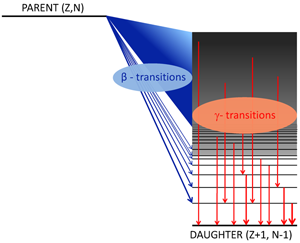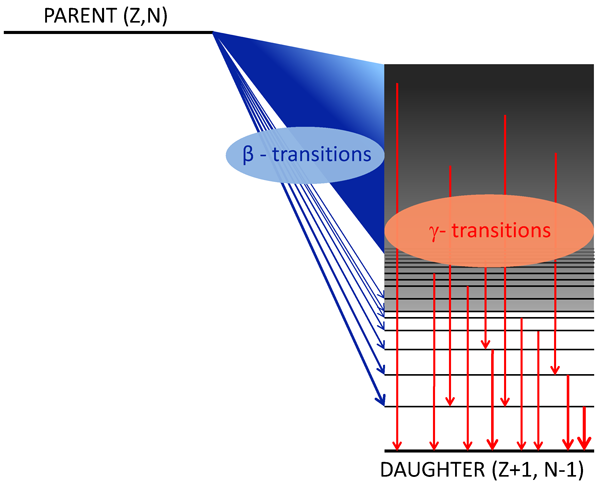Conquering nuclear pandemonium
We are entering an era of “nuclear renaissance” motivated by the diminishing supply and increasing cost of fossil fuels and their negative impact on our environment. Nuclear power, as an affordable energy source that does not emit CO2, will continue to be a significant component of a portfolio of technologies that meets world-wide energy production goals; see, e.g., the position paper of the European Physical Society [1] and the U.S. DOE Nuclear Energy Research and Development Roadmap [2]. Although the principles of reactor operation are well established, the sustainability of energy production from fissionable materials must be improved to meet future energy challenges. As future nuclear fuel cycles are investigated, a new focus is needed on studies of the materials involved in nuclear energy generation and on fission processes, in particular the fission products that are generated abundantly in nuclear power plants and that impact safety and waste management issues.
Uncertainties in nuclear data can lead to excessive, or even erroneous, margins for safety in the operation of fission reactors [3] as well as in waste handling and potential transmutation [4]. Efforts to improve cross-section data for the design of advanced reactor systems are underway. Although nuclear decay data are generally considered better understood than cross-section data, deficiencies in decay data remain. A commensurate level of effort is needed to advance the state of nuclear decay data [5]. In particular, the energy released during radioactive decay by post-fission processes, commonly called decay heat, must be better understood—as pointed out in a recent assessment performed under the auspices of the Nuclear Energy Agency of the Organization for Economic Co-operation and Development [6]. It is this issue that motivates the work of a large international collaboration (Algora et al.) reporting in Physical Review Letters [7], which resolves some outstanding puzzles on reactor decay heat from 239Pu.
Decay heat accounts for about 8% of the energy production in the fission process [7,8]. The accurate characterization of decay heat is crucial to the design of reactor shut-down and emergency core cooling systems, since it is the main source of heating after neutron-induced fission is terminated [1,7–10]. The decay energy (in particular, the high-energy part of the gamma-radiation spectrum emitted in the decay) also needs to be understood for proper design of shielding and storage casks for transportation and storage of spent nuclear fuel. Measurements on several fission products were recommended recently [6] to improve the present unsatisfactory status of decay heat data.
The products of fission process in nuclear fuel are neutron rich, i.e., have a large excess of neutrons over protons. This creates conditions allowing for several beta decay transitions to occur. The allowed Gamow-Teller beta transitions (no parity change, maximum spin change of 1ħ unit) compete with the “first-forbidden” ones (parity change, spin change up to 2ħ). The states fed by the allowed Gamow-Teller transitions, with higher transition matrix elements, are pushed up towards higher excitation energies by the residual nuclear interactions (see, e.g., shell-model predictions [11]). The resulting beta feeding to the levels in a daughter nucleus is highly fragmented; i.e., many states are populated, each with a small beta branching ratio. The weak beta transitions are followed by cascades of gamma transitions ending at the ground state of the daughter nucleus.
These gamma cascades usually pass through a few discrete, low-energy levels, collecting the gamma intensity at the bottom of the decay scheme. The individual weak gamma transitions at the top of the cascades are very difficult, or impossible, to detect with radiation detectors optimized for good energy resolution but having a low efficiency. The resulting “apparent” gamma intensity balance in the decay of a neutron-rich nucleus artificially enhances the beta feeding to the low-energy states that are, in reality, populated by several unobserved gamma transitions (Fig. 1). This phenomenon was analyzed by Hardy and collaborators in 1977 [12] using an “unstructured” fictional nucleus named Pandemonium, after the city at the center of hell in John Milton’s 17th century poem Paradise Lost. Pandemonium has been adopted into common English as a word meaning “uproar,” “utter confusion,” or “state of chaos.” Indeed, attempts to derive the true beta strength distribution and the resulting gamma decay pattern from low-efficiency measurements may lead us to chaos in the interpretation and applications of such data.
There is a method to determine the true beta feeding pattern: measure weak, often high-energy, gamma transitions with a large-volume, high-efficiency detection system, and construct a decay scheme having the correct gamma intensity balance. The counting efficiency should be as near to 100% as achievable over a wide energy range. The experimental technique that offers the highest detection efficiency is based on detectors made of large scintillator crystals. These total absorption gamma spectrometers (TAGS) [6,13–15] attempt to cover nearly a full solid angle around the activity being studied. TAGS detectors have rather poor energy resolution, typically about 6% full width at half maximum at 1.3MeV. However, the cascades of gamma radiation can be efficiently summed up inside the detector. Proper deconvolution of TAGS spectra [16] leads to decay schemes representing a nearly true feeding and decay pattern. Yes, we can conquer nuclear Pandemonium.
The TAGS technique alone is not enough to get a reliable measurement of a decay heat for nuclei of interest; one has to produce and select the activity to be studied. The absence of the contamination and low background is particularly important when using high-efficiency detectors. Algora et al. [7] combined several sophisticated techniques developed at the University of Jyväskylä to achieve this goal. Neutron-rich nuclei were produced in proton-induced fission of 238U targets placed inside the Ion Guide Isotope Separator On-Line (IGISOL). Fission products recoiling from the target, including refractory elements that are difficult to extract from conventional ion sources, were stopped in helium and transported by gas flow into the acceleration stage of a mass separator. The Jyväskylä Penning trap, which provides a mass resolving power M:ΔM around 105, was coupled for the first time to the TAGS to produce isotopically pure sources. After a nontrivial analysis of measured TAGS spectra of these pure sources, the decay properties of 101Nb, 105Mo, and 102-107Tc revealed a “decay heat” energy component that was missing in the earlier experiments. Inclusion of new results in the calculations of the electromagnetic decay heat component for 239Pu fission yielded much better agreement with the reference integral data, in particular for the period of 4 to 3000s after fission.
The work by Algora et al. paves the way for advanced decay studies of fission products focused on nuclear fuel cycle needs. Modern radioactive ion beam (RIB) facilities have powerful separation techniques and radiation detection arrays. Isotopically separated and postaccelerated radioactive beams are an ideal tool for the measurements of absolute branching ratios. The postaccelerated ions can be directly counted and identified by energy-loss signals during the collection of radioactive samples measured using efficiency-calibrated detectors, see, e.g., [17,18]. Such applied decay studies on neutron-rich nuclei should become an increasingly important fraction of the scientific programs at RIB facilities. We should remember that even the very best simulations of nuclear fuel cycles require correct experimental input data.
References
- European Physical Society, position paper, “Energy for the Future. The Nuclear Option.” http://nuclear.epsdivisions.org/reports/eps-position-paper-energy-for-the-future
- U.S. Department of Energy, Report to Congress, “Nuclear Energy Research and Development Roadmap,” April 2010; http://www.ne.doe.gov/pdfFiles/NuclearEnergy_Roadmap_Final.pdf
- A. D’angelo, Prog. Nucl. Energy 41, 1 (2002)
- W. Gudowski, Nucl. Phys. A663, 169c (2000)
- Report of the Nuclear Physics and Related Computations Science R&D for Advanced Fuel Cycles Workshop, Bethesda, Maryland, August 10-12, 2006, http://www-fp.mcs.anl.gov/nprcsafc/
- Assessment of Fission Product Decay Data for Decay Heat Calculations: A report by the Working Party on International Evaluation Co-operation of the Nuclear Energy Agency Nuclear Science Committee, Nuclear Science, NEA/WPEC-25, NEA No. 6284, (NEA OECD, Paris, 2007)[Amazon][WorldCat]; http://www.nea.fr/html/science/wpec/volume25/volume25.pdf
- A. Algora et al., Phys. Rev. Lett. 105, 202501 (2010)
- A. L. Nichols, in Proceedings of the Frederic Joliot Otto Hahn Summer School in Reactor Physics 2000: Modern Reactor Physics and the Modeling of Complex Systems, p. 211 and references therein
- T. Yoshida et al., J. Nucl. Sci. Technol. 36, 135 (1999)
- A. L. Nichols “Nuclear Data Requirements for Decay Heat Calculations,” Lectures given at the Workshop on Nuclear Reaction Data and Nuclear Reactors: Physics, Design and Safety, Trieste, Italy, 25 February - 28 March 2002; http://users.ictp.it/~pub_off/lectures/lns020/Nichols/Nichols.pdf
- J. Dobaczewski, Z. Szymanski, and J. Zylicz, in Proceedings of the Workshop on Nuclear Fission and Fission Product Spectroscopy, Seyssins, 1994, edited by H. Faust and G. Fioni (Institut Max von Laue, Grenoble, 1994)
- J. C. Hardy et al., Phys. Lett. 71B, 307 (1977)
- R. G. Greenwood et al., Nucl. Instrum. Methods Phys. Res., Sect. A 314, 514 (1992)
- M. Karny et al., Nucl. Instrum Methods Phys. Res., Sect. B 126, 41 (1997)
- E. Poirier et al., Phys. Rev. C 69, 034307 (2004)
- J. L. Tain and D. Cano-Ott, Nucl. Instrum. Methods Phys. Res., Sect. A 571, 719 (2007); 571, 728 (2007)
- C. J. Gross et al., Eur. Phys. J. A 25, Suppl. 1, 115 (2005)
- J. A. Winger et al., Phys. Rev. Lett 102, 142502 (2009)





